
Решил поделиться руководствами по обслуживанию и ремонту Infiniti FX35/45 в кузове S50.
Руководство написано уже под рестайл, но и для дорестайлинговых машин подходить будет на 98%.
Там все электрические схемы, узлы, вся механика и т.п.
Также содержатся все регламенты по обслуживанию всех систем автомобиля.
Еще отдельной книжкой идет руководство по кузовному ремонту. В нем кстати присутствуют все расстояния между контрольным точками, чтобы проверять геометрию кузова и каждого его элемента.
Возможно кому-то будет полезно что-то из этого.
1. Руководство по ремонту и эксплуатации Infiniti FX35/45 S50 2002—2008 (русский язык)
2. Руководство по ремонту и эксплуатации Infiniti FX35/45 S50 2002—2008 (английский язык)
3. Руководство по кузовному ремонту

Foreword
Your INFINITI represents a new way of thinking about vehicle design. It integrates advanced engineering and superior craftsmanship with a simple, refined aesthetic sensitivity associated with traditional Japanese culture.
The result is a different notion of luxury and beauty. The car itself is important, but so is the sense of harmony that the vehicle evokes in its driver, and the sense of satisfaction you feel with the INFINITI Ð from the way it looks and drives to the high level of dealer service.
To ensure that you enjoy your INFINITI to the fullest, we encourage you to read this Owner’s Manual immediately. It explains all of the features, controls and performance characteristics of your INFINITI; it also provides important instructions and safety information.
A separate Warranty Information Booklet can be found in your Owner’s literature portfolio. The INFINITI Service and Maintenance Guide explains details about maintaining and servicing your vehicle. Always carry it with you when you take your INFINITI to an authorized dealer. The portfolio contents provide complete information about all warranties covering this vehicle, the periodic maintenance required to keep the warranties in effect as well as
the INFINITI Roadside Assistance program.
Additionally, a separate Customer Care and Lemon Law Information Booklet will explain how to resolve any concerns you may have with your vehicle, as well as clarify your rights under your state’s lemon law.
READ FIRST Ð THEN DRIVE SAFELY
Before driving your vehicle please read your Owner’s Manual carefully. This will ensure familiarity with controls and maintenance requirements, assisting you in the safe operation of your vehicle.

IMPORTANT SAFETY INFORMATION REMINDERS FOR SAFETY!
Follow these important driving rules to help ensure a safe and comfortable trip for you and your passengers!
ONEVER drive under the influence of alcohol or drugs.
OALWAYS observe posted speed limits and never drive too fast for conditions.
OALWAYS give your full attention to driving and avoid using vehicle features or taking other actions that could distract you.
OALWAYS use your seat belts and appropriate child restraint systems. Preteen children should be seated in the rear seat.
OALWAYS provide information about the proper use of vehicle safety features to all occupants of the vehicle.
OALWAYS review this Owner’s Manual for important safety information.
MODIFICATION OF YOUR VEHICLE
This vehicle should not be modified. Modification could affect its performance, safety or durability, and may even violate governmental regulations. In addition, damage or performance problems resulting from modifications may not be covered under INFINITI warranties.
WHEN READING THE MANUAL
This manual includes information for all options available on this model. Therefore, you may find some information that does not apply to your vehicle.
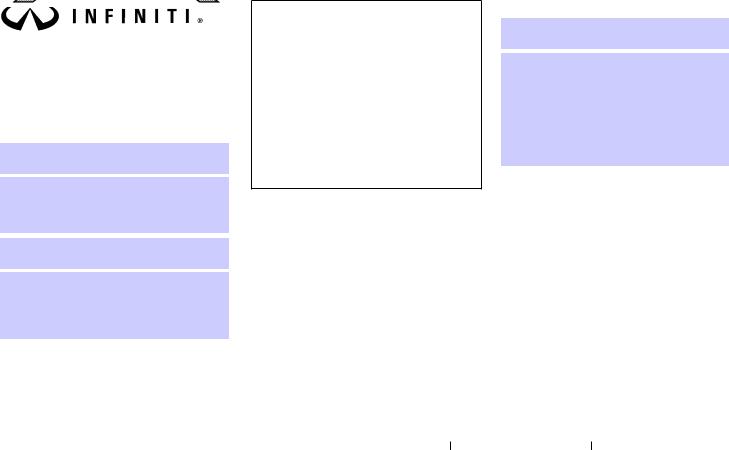
All information, specifications and illustrations in this manual are those in effect at the time of printing. INFINITI reserves the right to change specifications or design at any time without notice.
IMPORTANT INFORMATION ABOUT THIS MANUAL
You will see various symbols in this manual. They are used in the following ways:

This is used to indicate the presence of a hazard that could cause death or serious personal injury. To avoid or reduce the risk, the procedures must be followed precisely.

This is used to indicate the presence of a hazard that could cause minor or moderate personal injury or damage to your vehicle. To avoid or reduce the risk, the procedures must be followed carefully.
SIC0697
If you see this symbol, it means Do not do this or Do not let this happen.
If you see a symbol similar to these in an illustration, it means the arrow points to the front of the vehicle.
Arrows in an illustration that are similar to these indicate movement or action.
Arrows in an illustration that are similar to these call attention to an item in the illustration.
CALIFORNIA PROPOSITION 65 WARNING

Engine exhaust, some of its constituents, and certain vehicle components contain or emit chemicals known to the State of California to cause cancer and birth defects or other reproductive harm. In addition, certain fluids contained in vehicles and certain products of component wear contain or emit chemicals known to the State of California to cause cancer and birth defects or other reproductive harm.
CALIFORNIA PERCHLORATE ADVISORY Some vehicle parts, such as lithium batteries, may contain perchlorate material. The following advisory is provided: ªPerchlorate Material — special handling may apply, See www.dtsc.ca.gov/hazardouswaste/perchlorate.º
BLUETOOTH
© 2007 NISSAN MOTOR CO., LTD.
All rights reserved. No part of this Owner’s Manual may be reproduced or stored in a retrieval system, or transmitted in any form, or by any means, electronic, me-
chanical, photocopying, recording or otherwise, without the prior written permission of Nissan Motor Co., Ltd.

INFINITI CUSTOMER CARE PROGRAM
INFINITI CARES …
Both INFINITI and your INFINITI dealer are dedicated to serving all your automotive needs. Your satisfaction with your vehicle and your INFINITI dealer are our primary concerns. Your INFINITI dealer is always available to assist you with all your automobile sales and service needs.
However, if there is something that your INFINITI dealer cannot assist you with or you would like to provide INFINITI directly with comments or questions, please contact our (INFINITI’s) Consumer Affairs Department using our toll-free number:
For U.S. customers 1-800-662-6200
For Canadian customers 1-800-361-4792
The Consumer Affairs Department will ask for the following information:
ÐYour name, address, and telephone number
ÐVehicle identification number (on dash panel)
ÐDate of purchase
ÐCurrent odometer reading
ÐYour INFINITI dealer’s name
ÐYour comments or questions
OR
You can write to INFINITI with the information on the left at:
For U.S. customers INFINITI Division
Nissan North America, Inc. Consumer Affairs Department P.O. Box 685003
Franklin, TN 37068-5003 For Canadian customers
INFINITI Division Nissan Canada Inc. 5290 Orbitor Drive
Mississauga, Ontario L4W 4Z5
We appreciate your interest in INFINITI and thank you for buying a quality INFINITI vehicle.

|
Illustrated table of contents |
0 |
|
|
Safety Ð Seats, seat belts and supplemental restraint system |
1 |
|
|
Instruments and controls |
2 |
|
|
Pre-driving checks and adjustments |
3 |
|
|
Display screen, heater, air conditioner and audio systems |
4 |
|
|
Starting and driving |
5 |
|
|
In case of emergency |
6 |
|
|
Appearance and care |
7 |
|
|
Maintenance and do-it-yourself |
8 |
|
|
Technical and consumer information |
9 |
|
|
Index |
10 |
|
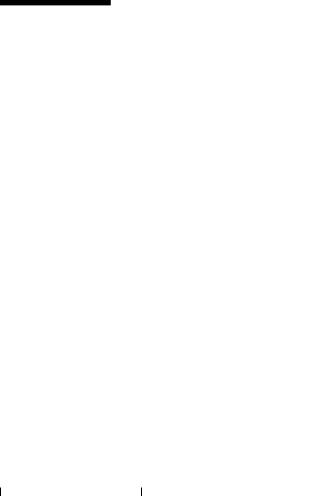
0 Illustrated table of contents
|
Seats, seat belts and Supplemental Restraint |
|
|
System (SRS)……………………………………………. |
0-2 |
|
Exterior……………………………………………………. |
0-3 |
|
Instrument panel ………………………………………. |
0-4 |
|
Passenger compartment …………………………….. |
0-5 |
|
Meters and gauges……………………………………. |
0-7 |
|
Engine compartment …………………………………. |
0-8 |
|
VQ35DE engine ……………………………………. |
0-8 |
|
VK45DE engine …………………………………… |
0-9 |
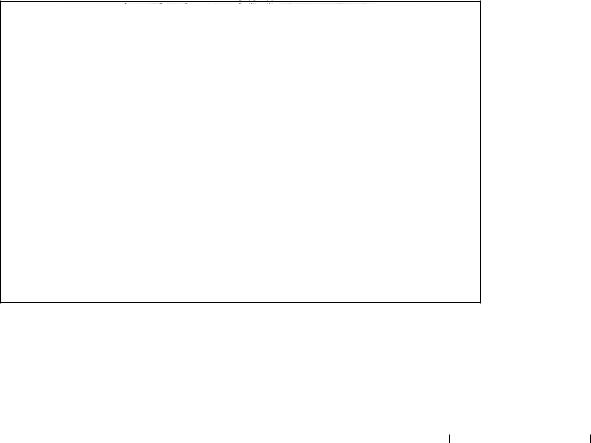
SEATS, SEAT BELTS AND SUPPLEMENTAL RESTRAINT SYSTEM (SRS)
6. Supplemental front-impact air bags
(P.1-38)
7. Rear seats (P.1-4)
Ð Child restraints (P.1-19)
8. Lower Anchors and Tethers for CHildren (LATCH) system (P.1-21)
9. Rear armrest (P.1-8)
10. Front seat-mounted side-impact supplemental air bag (P.1-38)
11. Front seats (P.1-2)
SSI0323
1.Child restraint anchor point (for top tether strap child restraint) (P.1-23)
2.Seat belts (P.1-8)
3.Front-seat Active Head Restraints (P.1-7)
0-2 Illustrated table of contents
4.Roof-mounted curtain side-impact and rollover supplemental air bag modules (P.1-38)
5.Seat belt pretensioner (P.1-52)
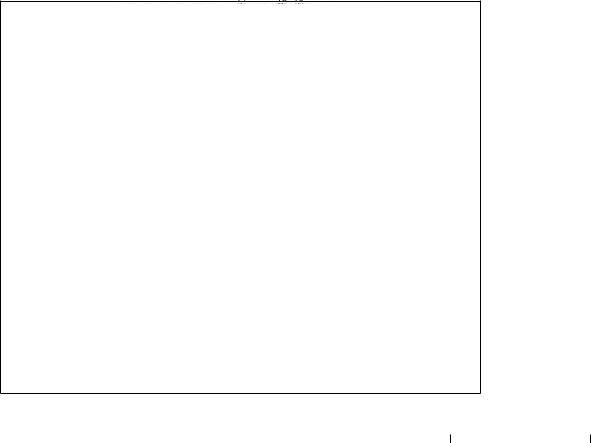
EXTERIOR
1. Hood (Page 3-23)
2. Headlight and turn signal switch
(P.2-23)
3. Wiper and washer switch (P.2-21)
4. Windshield (P.8-21)
5. Sunroof (if so equipped) (P.2-42)
6. Power windows (P.2-40)
7. Recovery hook (P.6-16)
8. Fog light and switch (P.2-28)
9. Tires
Ð Wheel and tires (P.8-35, 9-9) Ð Flat tire (P.6-2)
10. Mirrors (P.3-30)
11. Doors (P.3-3)
Ð Keys
Ð Door locks
Ð Remote keyless entry system Ð Intelligent Key (if so equipped)
12. Lift gate (P.3-23)
13. Rear window wiper (P.8-23)
14. Rear combination light (P.8-33)
15. Fuel-filler door (P.3-25)
16. Child safety rear door lock (P.3-5)
SSI0012A
Illustrated table of contents 0-3
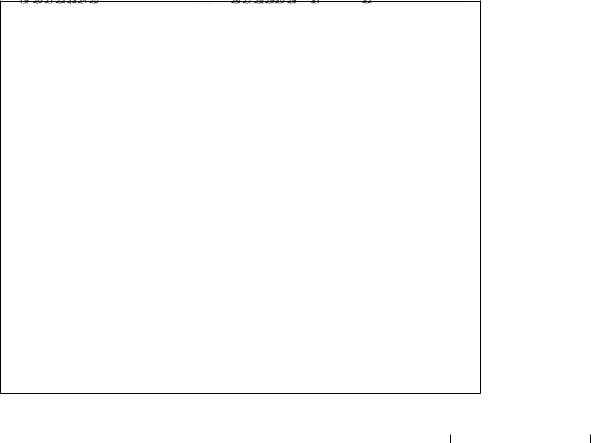
INSTRUMENT PANEL
1. Outside mirror remote control (P.3-31)
2. Headlight, fog light and turn signal switch (P.2-23)
3. Trip odometer reset knob (P.2-4)
4. Instrument brightness control switch
(P.2-27)
5. Headlight aiming control switch
(P.2-26)
6. Trip odometer select knob (P.2-4)
7. Steering switch for Audio (P.4-40)/ Bluetooth
8. Security indicator light (P.2-18)
9. Meters and gauges (P.2-3)
10. Driver supplemental air bag (P.1-38)
11. Cruise control main/set switch
(P.5-23) or Intelligent cruise control switch (if so equipped) (P.5-25)
12. Windshield wiper/washer switch
(P.2-21)
13. Ignition switch (P.5-10)
14. Center ventilator (P.4-20)
15. Display (P.4-4)/Navigation system (if so equipped)*
16. Audio system (P.4-26)
17. Center multi-function control panel
(P.4-2)
18. Front passenger supplemental air bag
(P.1-38)
SSI0182
0-4 Illustrated table of contents
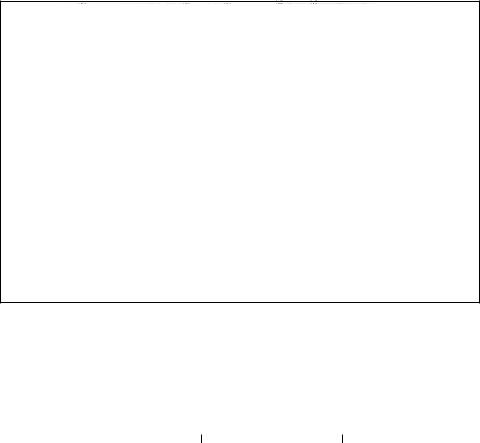
19.Lane Departure Warning (LDW) switch (if so equipped) (P.2-30)
20.Hood release handle (P.3-23)
21.Fuse box (P.8-24)
22.SNOW mode switch (P.2-31)
23.Parking brake (P.5-18)
24.Vehicle Dynamic Control (VDC) OFF switch (P.2-31)
25.Tilting/telescopic steering wheel switch (P.3-28)
26.Storage box and power outlet (P.2-33, P.2-35)
27.Hazard warning flasher switch (P.2-28)
28.Automatic transmission selector lever (P.5-15)
29.Heated seat switch (P.2-29)
30.Clock (P.2-32)
31.Automatic climate control system (P.4-22)
32.Glove box (P.2-36)
*: Refer to the separate Navigation System Owner’s Manual. (if so equipped)
PASSENGER COMPARTMENT
SSI0324
1.Luggage room light (P.2-49)
2.Rear personal lights (P.2-46)
3.Mobile Entertainment System (MES)* Ð Flip-down screen (P.4-58)
ÐDigital Versatile Disc (DVD) player (P.4-56)
ÐDVD remote controller (P.4-57)
ÐHeadphones (P.4-59)
4.Automatic drive positioner switch (P.3-31)
Illustrated table of contents 0-5

5.Driver’s door armrest
ÐPower window switch (P.2-40)
ÐPower door lock switch (P.3-4)
6.Sun visors (P.2-28)
7.Sunroof (P.2-42)
8.Front map lights (P.2-44)
9.Sunglasses holder (P.2-34)
10.Microphone (Bluetooth
11.Inside rearview mirror
ÐAnti-glare adjustment (P.3-29)
ÐCompass (P.2-6)
ÐHomeLink
12.Luggage room
ÐTonneau cover* (P.2-39)
ÐCargo net* (P.2-39)
ÐPower outlet (P.2-33)
ÐSpare tire* (P.6-4)
ÐLuggage floor boxes* (P.2-38)
13.Rear armrest (P.1-8)
14.Rear cup holders (P.2-36)
15.Console box (P.2-37)
16. Front cup holders (P.2-36) * if so equipped
0-6 Illustrated table of contents
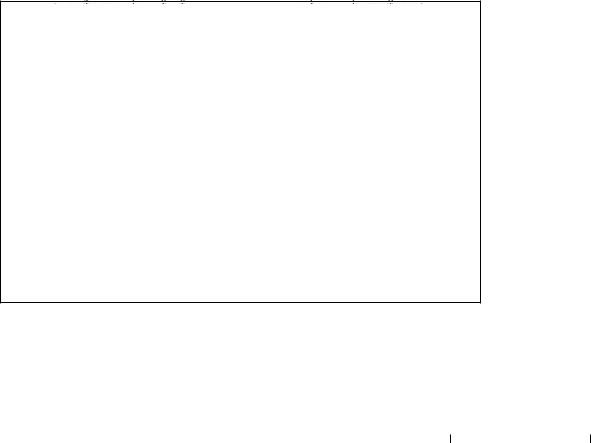
METERS AND GAUGES
SIC2135
1.Warning/Indicator lights (P.2-9)
2.Tachometer (P.2-4)
3.Speedometer (P.2-4)
4.Engine coolant temperature gauge (P.2-5)
5.Intelligent cruise control system display (if so equipped) (P.5-25)
6.Automatic transmission position indicator (P.5-15)
7.Odometer (Total/Twin trip) (P.2-4)
8.Fuel gauge (P.2-5)
Illustrated table of contents 0-7
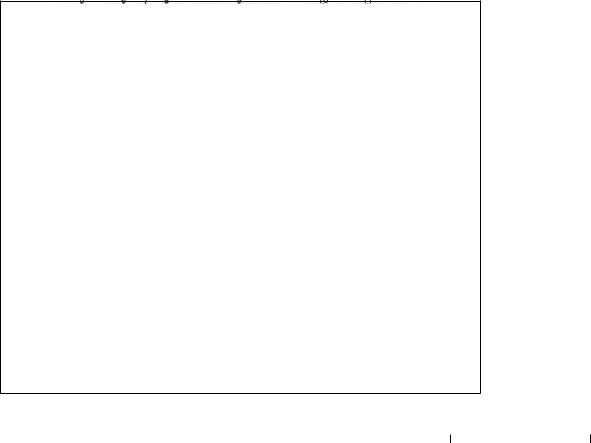
ENGINE COMPARTMENT
VQ35DE ENGINE
1. Fuse/fusible link holder (P.8-24)
2. Battery (P.8-17)
3. Engine oil filler cap (P.8-13)
4. Brake fluid reservoir (P.8-16)
5. Engine coolant reservoir (P.8-9)
6. Window washer fluid reservoir
(P.8-16)
7. Power steering fluid reservoir (P.8-15)
8. Radiator filler cap (P.8-9)
9. Drive belts (P.8-19)
10. Engine oil dipstick (P.8-11)
11. Air cleaner (P.8-21)
SDI1991
0-8 Illustrated table of contents
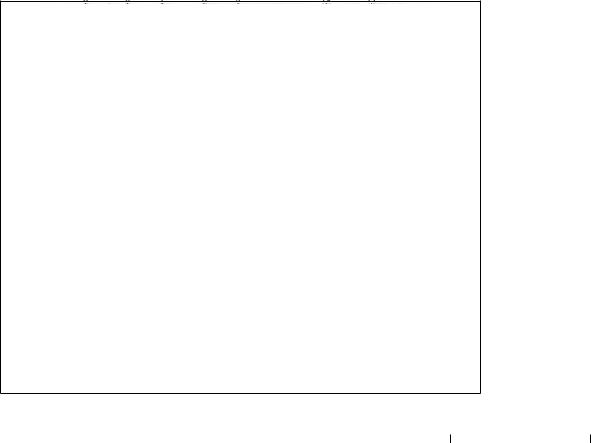
VK45DE ENGINE
1.Fuse/fusible link holder (P.8-24)
2.Battery (P.8-17)
3.Engine oil filler cap (P.8-13)
4.Brake fluid reservoir (P.8-16)
5.Engine coolant reservoir (P.8-9)
6.Window washer fluid reservoir (P.8-16)
7.Power steering fluid reservoir (P.8-15)
8.Radiator filler cap (P.8-9)
9.Drive belts (P.8-19)
10.Engine oil dipstick (P.8-11)
11.Air cleaner (P.8-21)
SDI1987
Illustrated table of contents 0-9

MEMO
0-10 Illustrated table of contents
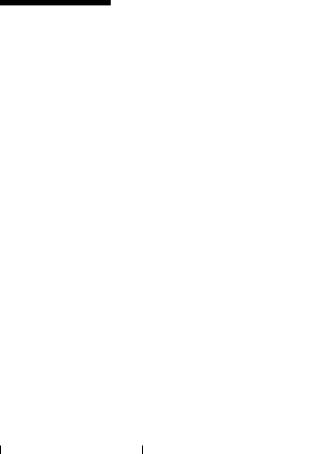
1Safety Ð Seats, seat belts and supplemental restraint system
|
Seats ………………………………………………………. |
1-2 |
|
Front power seat adjustment ………………….. |
1-2 |
|
Rear seat adjustment…………………………….. |
1-4 |
|
Head restraint adjustment ……………………… |
1-6 |
|
Front-seat Active Head Restraints …………… |
1-7 |
|
Armrest……………………………………………….. |
1-7 |
|
Seat belts ………………………………………………… |
1-8 |
|
Precautions on seat belt usage……………….. |
1-8 |
|
Child safety ………………………………………… |
1-11 |
|
Pregnant women …………………………………. |
1-12 |
|
Injured persons …………………………………… |
1-12 |
|
Three-point type seat belt with retractor….. |
1-12 |
|
Rear center seat belt ……………………………. |
1-15 |
|
Seat belt extenders ……………………………… |
1-18 |
|
Seat belt maintenance …………………………. |
1-18 |
|
Child restraints………………………………………… |
1-19 |
|
Precaution on child restraints………………… |
1-19 |
|
Lower Anchors and Tethers for CHildren |
|
|
system (LATCH)……………………………………. |
1-21 |
|
Top tether strap child restraint ……………… |
1-23 |
|
Child restraint installation using LATCH ….. |
1-24 |
|
Child restraint installation using the seat |
|
|
belts …………………………………………………. |
1-27 |
|
Booster seats………………………………………….. |
1-34 |
|
Precautions on booster seats ………………. |
1-34 |
|
Booster seat installation ………………………. |
1-36 |
|
Supplemental restraint system…………………… |
1-38 |
|
Precautions on supplemental restraint |
|
|
system………………………………………………. |
1-38 |
|
INFINITI advanced air bag system |
|
|
(front seats) ……………………………………….. |
1-45 |
|
Supplemental air bag warning labels ……… |
1-53 |
|
Supplemental air bag warning light ……….. |
1-54 |


ODo not ride in a moving vehicle when the seatback is reclined. This can be dangerous. The shoulder belt will not be against your body. In an accident, you could be thrown into it and receive neck or other serious injuries. You could also slide under the lap belt and receive serious internal injuries.
OFor the most effective protection when
the vehicle is in motion, the seat should be upright. Always sit well back in the seat with both feet on the floor and adjust the seat belt properly. See ªPrecautions on seat belt usageº later in this section.
ODo not leave children unattended inside the vehicle. They could unknowingly activate switches or controls. Unattended children could become involved in serious accidents.
1-2 Safety Ð Seats, seat belts and supplemental restraint system
The seat back should not be reclined any more than needed for comfort. Seat belts are most effective when the passenger sits well back and straight up in the seat. If the seatback is reclined, the risk of sliding under the lap belt and being injured is increased.

When adjusting the seat positions, be sure not to contact any moving parts to avoid possible injuries and/or damages.
FRONT POWER SEAT ADJUSTMENT Operating tips
OThe seat motor has an auto-reset overload protection circuit. If the motor stops during operation, wait 30 seconds, then reactivate the switch.
ODo not operate the power support seat for a long period of time when the engine is off. This will discharge the battery.
See ªAutomatic drive positionerº in the ª3. Pre-driving checks and adjustmentsº section for automatic drive positioner operation.
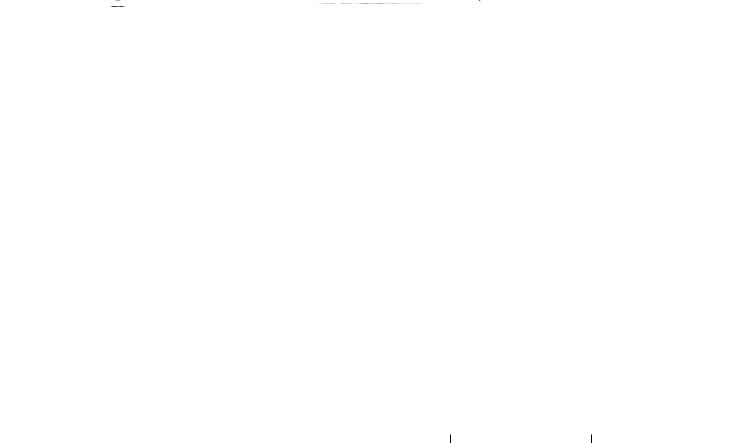
Forward and backward
Moving the switch q1 forward or backward will slide the seat forward or backward to the desired position.
Reclining
Move the recline switch q2 backward until the desired angle is obtained. To bring the seatback forward again, move the switch q2 forward.
The reclining feature allows adjustment of the seatback for occupants of different sizes for added comfort and to help obtain proper seat belt fit. See ªPrecautions on seat belt usageº later in this section. The seatback may be reclined to allow occupants to rest when the vehicle is stopped and the transmission is in the P (Park) position.
Seat lifter
Push the front or rear end of the switch up or down to adjust the height and angle of the seat.
For the front passenger’s seat, only the angle of the seat can be adjusted.
Safety Ð Seats, seat belts and supplemental restraint system 1-3
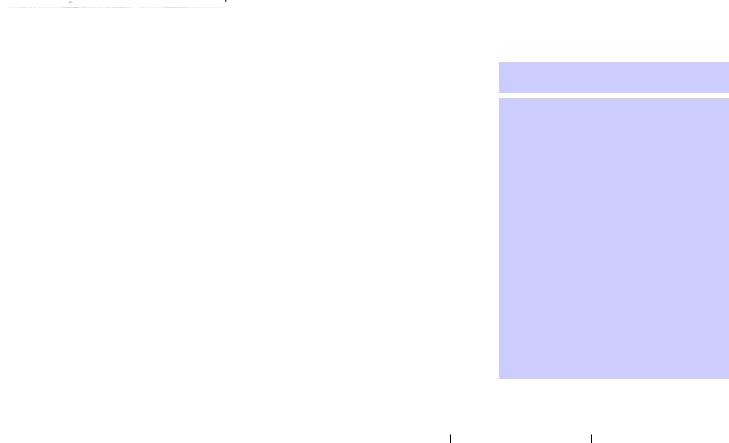
Lumbar support (if so equipped for driver’s seat)
The lumbar support feature provides lower back support to the driver. Push the front q1 or back q2 end of the switch to adjust the seat lumbar area.
REAR SEAT ADJUSTMENT
Folding
1.Store the center seat belts in the proper position. (See ªREAR CENTER SEAT BELTº later in this section.)
2.Slide the front seat forward if necessary. (See ªFRONT POWER SEAT ADJUSTMENTº earlier in this section.)
3.Pull the seat belt to side.
4.After removing the tonneau cover (if
so equipped), pull the lever on the rear seat qA or pull the lever on both
1-4 Safety Ð Seats, seat belts and supplemental restraint system
sides of the luggage room qB and fold the seatback.
5.When resetting the seat, be sure to install the head restraints.

ONever allow anyone to ride in the cargo area or on the rear seat when it is in the fold-down position. Use of these areas by passengers without proper restraints could result in serious injury in an accident or sudden stop.
OIt is extremely dangerous to ride in a cargo area inside a vehicle. In a collision, people riding in these areas are more likely to be seriously injured or killed.
ODo not allow people to ride in any area of your vehicle that is not equipped with seats and seat belts. Be sure everyone in your vehicle is in a seat and using a seat belt properly.
ODo not fold down the rear seats when occupants are in the rear seat area, any

luggage is on the rear seat or any cup is in the cup holder.
OHead restraints should be adjusted properly as they may provide significant protection against injury in an accident. Always replace and adjust them properly if they have been removed for any reason.
OIf the head restraints are removed for any reason, they should be securely stored to prevent them from causing injury to passengers or damage to the vehicle in case of sudden braking or an accident.
OProperly secure all cargo to help prevent it from sliding or shifting. Do not place cargo higher than the seatbacks. In a sudden stop or collision, unsecured cargo could cause personal injury.
OWhen returning the seatbacks to the upright position, be certain they are completely secured in the latched position. If they are not completely secured, passengers may be injured in an accident
or sudden stop.
OWhen returning the seatbacks, be sure to attach the rear center seat belt connector.
ODo not unfasten the rear center seat belt connector except when folding down the rear seat.
OWhen attaching the rear center seat belt connector, be certain that the seatbacks are completely secured in the latched position and the rear center seat belt connector is completely secured.
OIf the rear center seat belt connector and the seatbacks are not secured in the correct position, serious personal injury may result in an accident or sudden stop.
SSS0248
Reclining
Pull the reclining lever q1 and position the seat back at the desired angle q2 . Release the reclining lever q1 after positioning the seat at the desired angle q2 .

ODo not ride in a moving vehicle when the seatback is reclined. This can be dangerous. The shoulder belt will not be against your body. In an accident,
Safety Ð Seats, seat belts and supplemental restraint system 1-5
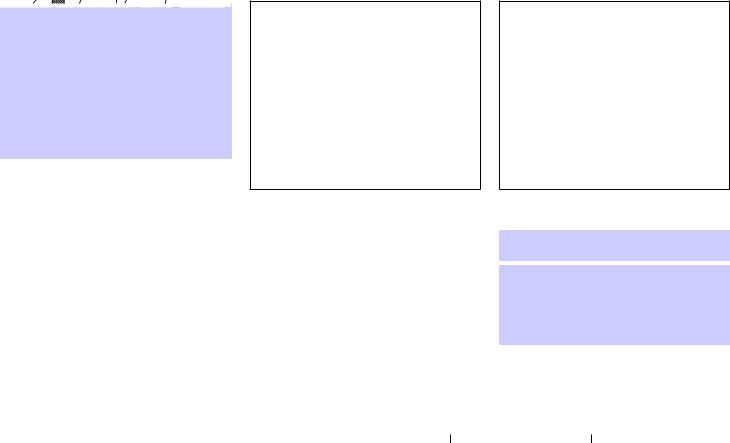
you could be thrown into it and receive neck or other serious injuries. You could also slide under the lap belt and receive serious internal injuries.
O For the most effective protection when the vehicle is in motion, the seat should be upright. Always sit well back in the seat and adjust the seat belt properly. See ªPrecautions on seat belt usageº later in this section.
SSS0125C
HEAD RESTRAINT ADJUSTMENT
To raise the head restraint, just pull it up. To lower, push the lock knob q1 and push the head restraint down.
1-6 Safety Ð Seats, seat belts and supplemental restraint system
SSS0287
Adjust the head restraints so the center is level with the center of your ears.

Head restraints should be adjusted properly as they may provide significant protection against injury in an accident. Do not remove them. Check the adjustment after someone else uses the seat.
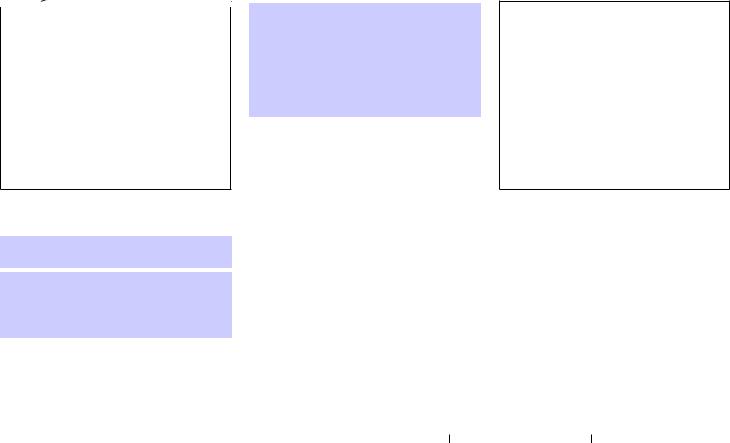
SSS0508
FRONT-SEAT ACTIVE HEAD
RESTRAINTS

OAlways adjust the head restraints properly as specified in the previous section. Failure to do so can reduce the effectiveness of the Active Head Restraint.
OActive Head Restraints are designed to supplement other safety systems. Always wear seat belts. No system can prevent all injuries in any accident.
ODo not attach anything to the head restraint stalks. Doing so could impair Active Head Restraint function.
The Active Head Restraint moves forward utilizing the force that the seatback receives from the occupant in a rear-end collision. The movement of the head restraint helps support the occupant’s head by reducing its backward movement and helping absorb some of the forces that may lead to whiplash type injuries.
Active Head Restraints are effective for collisions at low to medium speeds in which it is said that whiplash injury occurs most.
Active Head Restraints operate only in certain rear-end collisions. After the collision, the head restraints return to their original positions.
Properly adjust the Active Head Restraints as described in the previous section.
SSS0596
Front
ARMREST Front
Push the button q1 while sliding the armrest q2 to the desired position.
To use the console box, see ªConsole boxº in the ª2. Instruments and controlsº section.
Safety Ð Seats, seat belts and supplemental restraint system 1-7
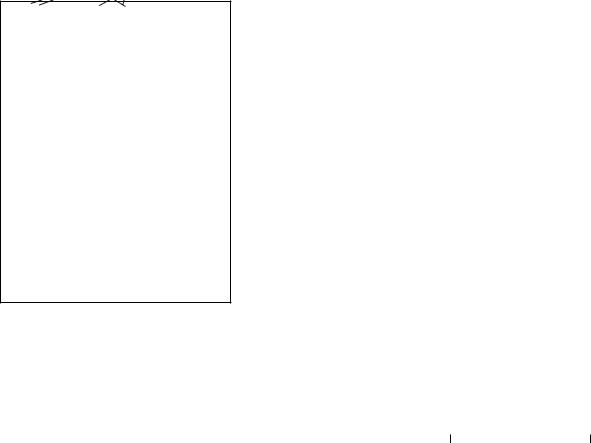
SEAT BELTS
PRECAUTIONS ON SEAT BELT USAGE
If you are wearing your seat belt properly adjusted, and you are sitting upright and well back in your seat with both feet on the floor, your chances of being injured or killed in an accident and/or the severity of injury may be greatly reduced. INFINITI strongly encourages you and all of your passengers to buckle up every time you drive, even if your seating position includes a supplemental air bag.
Most U.S. states and Canadian provinces or territories specify that seat belts be worn at all times when a vehicle is being driven.
SSS0243
Rear
Rear
Pull the armrest down until it is horizontal.
1-8 Safety Ð Seats, seat belts and supplemental restraint system

|
WAIST. A lap belt worn too high could in- |
|
|
crease the risk of internal injuries in an |
|
|
accident. |
|
|
O Be sure the seat belt tongue is securely |
|
|
fastened to the proper buckle. |
|
|
O Do not wear the seat belt inside out or |
|
|
twisted. Doing so may reduce its effec- |
|
|
tiveness. |
|
|
O Do not allow more than one person to |
|
|
use the same seat belt. |
|
|
SSS0136 |
O Never carry more people in the vehicle |
|
than there are seat belts. |

OEvery person who drives or rides in this vehicle should use a seat belt at all times. Children should be properly restrained in the rear seat and, if appropriate, in a child restraint.
OThe seat belt should be properly adjusted to a snug fit. Failure to do so may reduce the effectiveness of the entire restraint system and increase the chance
or severity of injury in an accident. Serious injury or death can occur if the seat belt is not worn properly.
OAlways route the shoulder belt over your shoulder and across your chest. Never put the belt behind your back, under your arm or across your neck. The belt should be away from your face and neck, but not falling off your shoulder.
OPosition the lap belt as low and snug as possible AROUND THE HIPS, NOT THE
OIf the seat belt warning light glows continuously while the ignition is turned ON with all doors closed and all seat belts fastened, it may indicate a malfunction in the system. Have the system checked by an INFINITI dealer.
OOnce a seat belt pretensioner system has activated, it cannot be reused and must be replaced together with the retractor. See an INFINITI dealer.
Safety Ð Seats, seat belts and supplemental restraint system 1-9
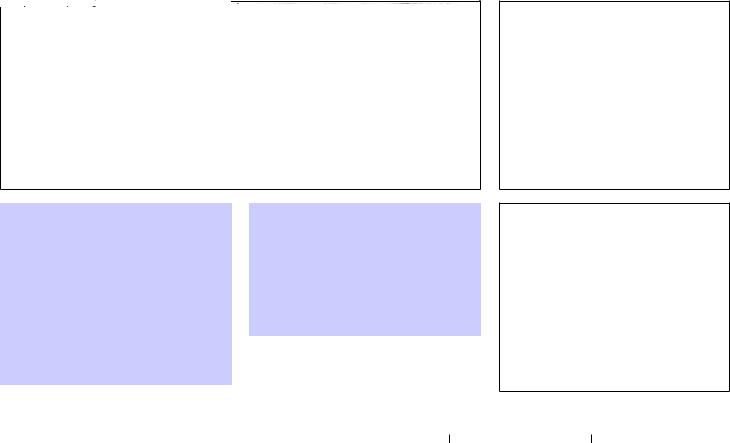
SSS0134
ORemoval and installation of pretensioner system components should be done by an INFINITI dealer.
OAll seat belt assemblies, including retractors and attaching hardware, should be inspected after any collision by an INFINITI dealer. INFINITI recommends that all seat belt assemblies in use during a collision be replaced unless the collision was minor and the belts show no damage and continue to operate properly. Seat belt assemblies not in use during a collision should also be in-
spected and replaced if either damage or improper operation is noted.
OAll child restraints and attaching hardware should be inspected after any collision. Always follow the restraint manufacturer’s inspection instructions and replacement recommendations. The child restraints should be replaced if they are damaged.
1-10 Safety Ð Seats, seat belts and supplemental restraint system
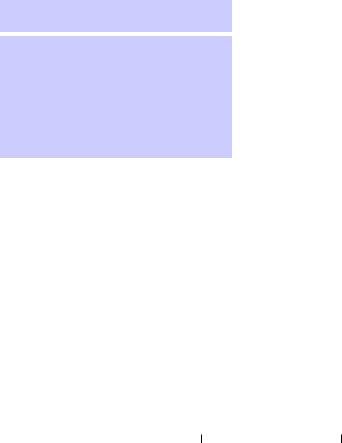
CHILD SAFETY
Children need adults to help protect them. They need to be properly restrained.
In addition to the general information in this manual, child safety information is available from many other sources, including doctors, teachers, government traffic safety offices, and community organizations. Every child is different, so be sure to learn the best way to transport your child.
There are three basic types of child restraint systems:
ORear facing child restraint
OFront facing child restraint
OBooster seat
The proper restraint depends on the child’s size. Generally, infants (up to about 1 year and less than 20 lb (9 kg)) should be placed in rear facing child restraints. Front facing child restraints are available for children who outgrow rear facing child restraints and are at least 1 year old. Booster seats are used to help position a vehicle lap/shoulder belt on a child who can no longer use a front facing child restraint.

Infants and children need special protection. The vehicle’s seat belts may not fit them properly. The shoulder belt may come too close to the face or neck. The lap belt may not fit over their small hip bones. In an accident, an improperly fitting seat belt could cause serious or fatal injury. Always use appropriate child restraints.
All U.S. states and Canadian provinces or territories require the use of approved child restraints for infants and small children. (See ªChild restraintsº later in this section.)
Also, there are other types of child restraints available for larger children for additional protection.
INFINITI recommends that all pre-teens and children be restrained in the rear seat. According to accident statistics, children are safer when properly restrained in the rear seat than in the front seat.
This is especially important because your vehicle has a supplemental restraint
system (air bag system) for the front passenger. See ªSupplemental restraint systemº later in this section.
Infants
Infants up to at least one year old should be placed in a rear facing child restraint. INFINITI recommends that infants be placed in child restraints that comply with Federal Motor Vehicle Safety Standards or Canadian Motor Vehicle Safety Standards. You should choose a child restraint which fits your vehicle and always follow the manufacturer’s instructions for installation and use.
Small children
Children that are over one year old and weigh at least 20 lb (9 kg) can be placed in a forward facing child restraint. Refer to the manufacturer’s instructions for minimum and maximum weight and height recommendations. INFINITI recommends that small children be placed in child restraints that comply with Federal Motor Vehicle Safety Standards or Canadian Motor Vehicle Safety Standards. You should choose a child restraint that fits your vehicle and always follow the manufacturer’s instructions for installation and use.
Safety Ð Seats, seat belts and supplemental restraint system 1-11
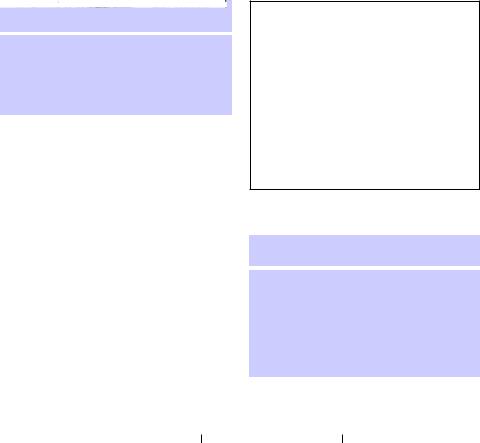
Larger children
Children who are too large for child restraints should be seated and restrained by the seat belts which are provided. The seat belt may not fit properly if the child is less than 4 ft 9 in (142.5 cm) tall and weighs between 40 lb (18 kg) and 80 lb (36 kg). A booster seat should be used to obtain proper seat belt fit.

Never let a child stand or kneel on any seat and do not allow a child in the cargo areas while the vehicle is moving. The child could be seriously injured or killed in an accident or sudden stop.
INFINITI recommends that a child be placed in a commercially available booster seat if the shoulder belt in the child’s seating position fits close to the face or neck or if the lap portion of the seat belt goes across the abdomen. The booster seat should raise the child so that the shoulder belt is properly positioned across the top, middle portion of the shoulder and the lap belt is low on the hips. A booster seat can only be used in seating positions that have a threepoint type seat belt. The booster seat should fit the vehicle seat and have a label certifying that it complies with Federal Motor Vehicle Safety Standards or Canadian Motor Vehicle Safety Standards. Once the child has grown so the shoulder belt is no longer on or near the face and neck, use the shoulder belt without the booster seat.
PREGNANT WOMEN
INFINITI recommends that pregnant women use seat belts. The seat belt should be worn snug, and always position the lap belt as low as possible around the hips, not the waist, and place the shoulder belt over your shoulder and across your chest. Never run the lap/shoulder belt over your abdominal area. Contact your doctor for specific recommendations.
INJURED PERSONS
INFINITI recommends that injured persons use seat belts, depending on the injury. Check with your doctor for specific recommendations.
1-12 Safety Ð Seats, seat belts and supplemental restraint system
SSS0292
Front seat
THREE-POINT TYPE SEAT BELT WITH RETRACTOR

OEvery person who drives or rides in this vehicle should use a seat belt at all times.
ODo not ride in a moving vehicle when the seatback is reclined. This can be dangerous. The shoulder belt will not be against your body. In an accident,
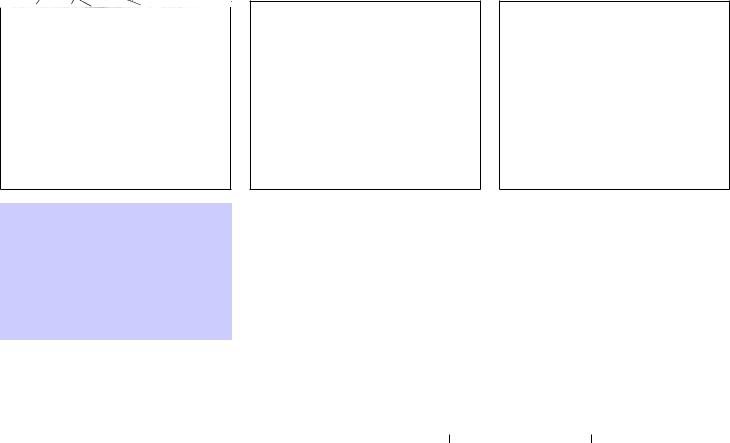
SSS0293
Rear seat
you could be thrown into it and receive neck or other serious injuries. You could also slide under the lap belt and receive serious internal injuries.
OFor the most effective protection when the vehicle is in motion, the seat should be upright. Always sit well back in the seat with both feet on the floor and adjust the seat belt properly.
SSS0290
Front seat
Fastening the seat belts
1.Adjust the seat. See ªSeatsº earlier in this section.
2.Slowly pull the seat belt out of the retractor and insert the tongue into the buckle until it clicks. (For additional information regarding the rear center seat belt, see ªSetting center seat beltº.)
OThe retractor is designed to lock during a sudden stop or on impact. A slow pulling motion will permit the belt to move, and allow you some freedom of movement in the seat.
SSS0291A
Rear seat
O If the seat belt cannot be pulled from its fully retracted position, firmly pull the belt and release it. Then smoothly pull the belt out of the retractor.
3.Position the lap belt portion low and snug on the hips as shown.
4.Pull the shoulder belt portion toward the retractor to take up extra slack. Be sure the shoulder belt is routed over
your shoulder and across your chest. The front passenger seat and the rear
seating positions three-point seat belts have two modes of operation:
OEmergency Locking Retractor (ELR)
OAutomatic Locking Retractor (ALR)
Safety Ð Seats, seat belts and supplemental restraint system 1-13
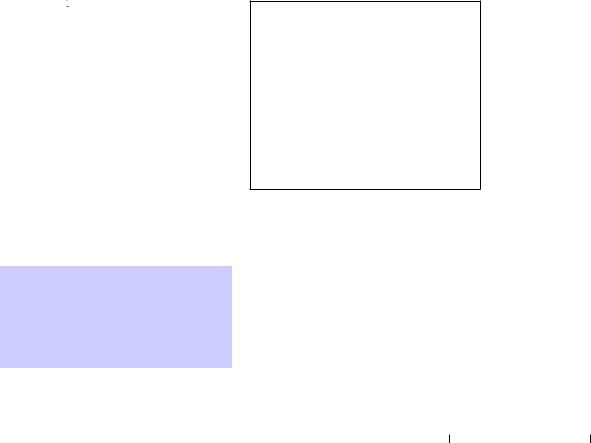
The Emergency Locking Rectractor (ELR) mode allows the seat belt to extend and retract to allow the driver and passengers some freedom of movement in the seat. The ELR locks the seat belt when the vehicle slows down rapidly or during certain impacts.
The Automatic Locking Retractor (ALR) mode (child restraint mode) locks the seat belt for child restraint installation.
When the ALR is activated the seat belt cannot be extended again until the seat belt tongue is detached from the buckle and fully retracted. The seat belt returns to the ELR mode after the seat belt fully retracts. For additional information, see ªChild restraintsº later in this section.
The ALR should be used only for child restraint installation. During normal seat belt use by a passenger, the ALR mode should not be activated. If it is activated it may cause uncomfortable seat belt tension. It can also change the operation of the front passenger air bag. See ªFront passenger air bag and status lightº later in this section.
SSS0326
Unfastening the seat belts
To unfasten the belt, press the button on the buckle. The seat belt will automatically retract.

When fastening the seat belts, be certain that the seatbacks are completely secured in the latched position. If they are not completely secured, passengers may be injured in an accident or sudden stop.
Checking seat belt operation
Your seat belt retractors are designed to lock belt movement using two separate methods:
Owhen the belt is pulled quickly from the retractor.
Owhen the vehicle slows down rapidly.
1-14 Safety Ð Seats, seat belts and supplemental restraint system
To increase your confidence in the seat belts, check the operation as follows:
O grasp the shoulder belt and pull quickly forward. The retractor should lock and restrict further belt movement.
If the retractor does not lock during this check or if you have any questions about belt operation, see an INFINITI dealer.

SSS0351
Shoulder belt height adjustment (for front seats)
The shoulder belt anchor height should be adjusted to the position best suited for you. (See ªPrecautions on seat belt usageº earlier in this section.) To adjust, pull the release button qA , and then move the shoulder belt anchor to the desired position, so that the belt passes over the center of the shoulder. The belt should be away from your face and neck, but not falling off of your shoulder. Release the adjustment button to lock the shoulder belt anchor into position.

OAfter adjustment, release the adjustment button and try to move the shoulder belt anchor up and down to make sure it is securely fixed in position.
OThe shoulder belt anchor height should be adjusted to the position best for you. Failure to do so may reduce the effectiveness of the entire restraint system and increase the chance or severity of injury in an accident.
SSS0240
REAR CENTER SEAT BELT
The rear center seat belt has a connector tongue q1 and a seat belt tongue q2 . Both the connector tongue and the seat belt tongue must be securely latched for proper seat belt operation.
Safety Ð Seats, seat belts and supplemental restraint system 1-15
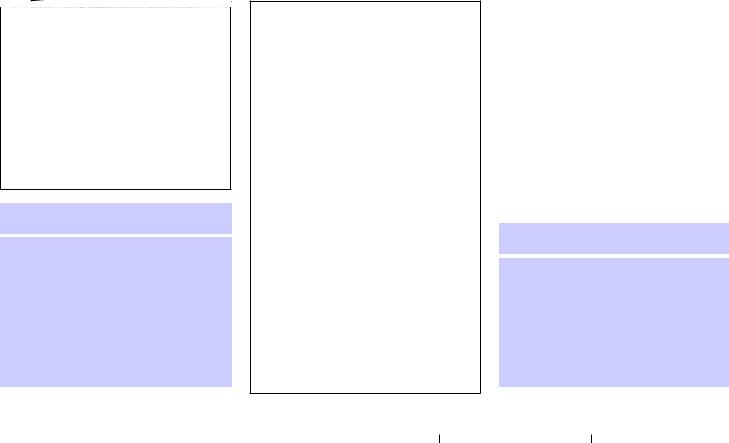
SSS0241

OAlways fasten the connector tongue and the seat belt in the order shown.
OAlways make sure both the connector tongue and the seat belt tongue are secured when using the seat belt or installing a child restraint. Do not use the seat belt or child restraint with only the seat belt tongue attached. This could result in serious personal injury in case of an accident or a sudden stop.
Stowing rear center seat belt
When folding down the rear seat, the rear center seat belt can be retracted into a stowed position as follows:
1.Hold the connector tongue q1 so that the seat belt does not retract suddenly when the tongue is released from the connector buckle.
2.Insert a suitable tool such as a key qA into the connector buckle and release the connector tongue.
3.Fold the connector as illustrated q2 .
4.Then secure the connector tongue into the retractor base q3 in the ceiling.

ODo not unfasten the rear center seat belt connector except when folding down the rear seat.
OWhen attaching the rear center seat belt connector, be certain that the seatbacks are completely secured in the latched position and the rear center seat belt connector is completely secured.
SSS0249
1-16 Safety Ð Seats, seat belts and supplemental restraint system

OIf the rear center seat belt connector and the seatbacks are not secured in the correct position, serious personal injury may result in an accident or sudden stop.
Attaching rear center seat belt
Always be sure the rear center seat belt connector tongue and connector buckle are attached. Disconnect only when folding down the rear seat.
To connect the buckle:
1.Pull out the seat belt tongue from the retractor base q1 in the ceiling.
2.Pull the seat belt and secure the connector buckle until it clicks q2 .
The center seat belt connector tongue and buckle are indicated by the ªDº and ªCº mark.
The center seat belt connector tongue can be attached only into the rear center seat belt connector buckle.
To fasten the seat belt, see ªFastening the seat beltº earlier in this section.

ODo not unfasten the rear center seat belt connector except when folding down the rear seat.
SSS0250
Safety Ð Seats, seat belts and supplemental restraint system 1-17

OWhen attaching the rear center seat belt connector, be certain that the seatbacks are completely secured in the latched position and the rear center seat belt connector is completely secured.
OIf the rear center seat belt connector and the seatbacks are not secured in the correct position, serious personal injury may result in an accident or sudden stop.
SEAT BELT EXTENDERS
If, because of body size or driving position, it is not possible to properly fit the lap-shoulder belt and fasten it, an extender is available. The extender adds approximately 8 in (200 mm) of length and may be used for either the driver or front passenger seating position. See an INFINITI dealer for assistance if the extender is required.

OOnly INFINITI seat belt extenders, made by the same company which made the original equipment seat belts, should be used with INFINITI seat belts.
OAdults and children who can use the standard seat belt should not use an extender. Such unnecessary use could result in serious personal injury in the event of an accident.
ONever use seat belt extenders to install child restraints. If the child restraint is not secured properly, the child could be seriously injured in a collision or a sudden stop.
SEAT BELT MAINTENANCE
O To clean the seat belt webbings, apply a mild soap solution or any solution recommended for cleaning upholstery or carpets. Then brush the webbing, wipe it with a cloth and allow it to dry in the shade. Do not allow the seat belts to retract until they are completely dry.
1-18 Safety Ð Seats, seat belts and supplemental restraint system
OIf dirt builds up in the shoulder belt guide of the seat belt anchors, the seat belts may retract slowly. Wipe the shoulder belt guide with a clean, dry cloth.
OPeriodically check to see that the seat belt and the metal components such as buckles, tongues, retractors, flexible wires and anchors work properly. If loose parts, deterioration, cuts or other damage on the webbing is found, the entire belt assembly should be replaced.

CHILD RESTRAINTS
SSS0099
PRECAUTION ON CHILD
RESTRAINTS

OInfants and small children should always be placed in an appropriate child restraint while riding in the vehicle. Failure to use a child restraint can result in serious injury or death.
OInfants and small children should never be carried on your lap. It is not possible
SSS0100
for even the strongest adult to resist the forces of a severe accident. The child could be crushed between the adult and parts of the vehicle. Also, do not put the same seat belt around both your child and yourself.
OEven with the INFINITI Advanced Air Bag System, never install a rear-facing child restraint in the front seat. An inflating front air bag could seriously injure or kill your child. A rear-facing child restraint must only be used in the rear seat.
OINFINITI recommends that the child restraint be installed in the rear seat. According to accident statistics, children are safer when properly restrained in the rear seat than in the front seat. If you must install a front facing child restraint in the front seat, see ªChild restraint installation using the seat beltsº in this section.
OImproper use or improper installation of a child restraint can increase the risk or severity of injury for both the child and other occupants of the vehicle and can lead to serious injury or death in an accident.
OFollow all of the child restraint manufacturer’s instructions for installation and use. When purchasing a child restraint, be sure to select one which will fit your child and vehicle. It may not be possible to properly install some types of child restraints in your vehicle.
OIf the child restraint is not anchored properly, the risk of a child being injured in a collision or a sudden stop greatly increases.
Safety Ð Seats, seat belts and supplemental restraint system 1-19

OChild restraint anchor points are designed to withstand only those loads imposed by correctly fitted child restraints. Under no circumstances are they to be used for adult seat belts or harnesses.
OAdjustable seatbacks should be positioned to fit the child restraint, but as upright as possible.
OAfter attaching the child restraint, test it before you place the child in it. Push it from side to side while holding the seat near the LATCH attachment or by the seat belt path. Try to tug it forward and check to see if the belt holds the restraint in place. The child restraint should not move more than 1 in (25 mm). If the restraint is not secure, tighten the belt as necessary, or put the restraint in another seating position and test it again. You may need to try a different child restraint. Not all child restraints fit in all types of vehicles.
OWhen your child restraint is not in use, keep it secured with LATCH System or a seat belt to prevent it from being thrown around in case of a sudden stop or accident.

Remember that a child restraint left in a closed vehicle can become very hot. Check the seating surface and buckles before placing your child in the child restraint.
This vehicle is equipped with a universal child restraint lower anchor system, referred to as the Lower Anchors and Tethers for CHildren System or LATCH. Some child restraints include two rigid or webbing-mounted attachments that can be connected to these lower anchors. For details, see ªLower Anchors and Tethers for CHildren System (LATCH)º in this section.
If you do not have a LATCH compatible child restraint, the vehicle seat belts can be used. See ªChild restraint installed using the seat beltsº later in this section. In general, child restraints are also designed to be installed with the lap portion of a lap/shoulder seat belt.
Several manufacturers offer child restraints for infants and small children of various sizes. When selecting any child
1-20 Safety Ð Seats, seat belts and supplemental restraint system
restraint, keep the following points in mind:
OChoose only a restraint with a label certifying that it complies with Federal Motor Vehicle Safety Standard 213 or Canadian Motor Vehicle Safety Standard 213.
OCheck the child restraint in your vehicle to be sure it is compatible with the vehicle’s seat and seat belt system.
OIf the child restraint is compatible with your vehicle, place your child in the child restraint and check the various adjustments to be sure the child restraint is compatible with your child. Choose a child restraint that is designed for your child’s height and weight. Always follow all recommended procedures.
All U.S. states and Canadian provinces or territories require that infants and small children be restrained in an approved child restraint at all times while the vehicle is being operated.

Lower Anchors and Tethers for CHildren SYSTEM (LATCH)
Your vehicle is equipped with special anchor points that are used with Lower Anchors and Tethers for CHildren System (LATCH) compatible child restraints. This system may also be referred to as the ISOFIX or ISOFIX compatible system. With this system, you do not have to use a vehicle seat belt to secure the child restraint.
The LATCH anchor points are provided to install child restraints in the rear outboard seating positions only. Do not attempt to install a child restraint in the center position using the LATCH anchors.
SSS0613A
LATCH label location
LATCH lower anchor point locations
The LATCH anchors are located at the rear of the seat cushion near the seatback. A label is attached to the seatback to help you locate the LATCH anchors.
SSS0637
LATCH lower anchor location

OAttach LATCH compatible child restraints only at the locations shown in the illustration. If a child restraint is not secured properly, your child could be seriously injured or killed in an accident.
ODo not secure a child restraint in the center rear seating position using the LATCH anchors. The child restraint will not be secured properly.
Safety Ð Seats, seat belts and supplemental restraint system 1-21

OChild restraint anchor points are designed to withstand only those loads imposed by correctly fitted child restraints. Under no circumstance are they to be used for adult seat belts or harnesses.
OIf the cargo cover contacts the top tether strap when it is attached to the top tether anchor — remove the cargo cover from the vehicle or secure it on the cargo floor below its attachment location. If the cargo cover is not removed, it may damage the top tether strap during a collision. Your child could be seriously injured or killed in a collision if the top tether strap is damaged.
ODo not allow cargo to contact the top tether strap when it is attached to the top tether anchor. Properly secure the cargo so it does not conatct the top tether strap. Cargo that is not properly secured or cargo that contacts the top tether strap may damage it during a collision. Your child could be seriously injured or killed in a collision if the top tether strap is damaged.
SSS0643
Latch webbing-mounted attachment
Installing child restraint LATCH anchor attachments
LATCH compatible child restraints include two rigid or webbing-mounted attachments that can be connected to two anchors located at certain seating positions in your vehicle. With this system, you do not have to use a vehicle seat belt to secure the child restraint. Check your child restraint for a label stating that it is compatible with LATCH. This information may also be in the instructions provided by the child restraint manufacturer.
1-22 Safety Ð Seats, seat belts and supplemental restraint system
SSS0644
LATCH rigid attachment
LATCH child restraints generally require the use of a top tether strap. See ªTop tether strap child restraintº in this section for installation instructions.
When installing a child restraint, carefully read and follow the instructions in this manual and those supplied with the child restraint. See ªChild restraint installation using LATCHº in this section.

SSS0709
TOP TETHER STRAP CHILD RESTRAINT
If the manufacturer of your child restraint requires the use of a top tether strap, it must be secured to an anchor point.

O Child restraint anchor points are designed to withstand only those loads imposed by correctly fitted child restraints. Under no circumstances are they to be
used for adult seat belts or harnesses.
OThe child restraint top tether strap may be damaged by contact with the tonneau cover or items in the cargo area. Remove the tonneau cover from the vehicle or secure it in the cargo area. Also secure any items in the cargo area. Your child could be seriously injured or killed in a collision if the top tether strap is damaged.
Top tether anchor point locations
Anchor points are located as illustrated. qA : for rear left side seat position
qB : for rear center seat position qC : for rear right side seat position
the top tether strap over the top of the seatback and secure it to the tether anchor bracket that provides the straightest installation. Tighten the tether strap according to the manufacturer’s instruction to remove any slack.
For best child restraint fit, see the child restraint installation instructions in this section and the child restraint manufacturer’s instructions.
If you have any questions when installing a top tether strap child restraint on the rear seat, consult your INFINITI dealer for details.
Installing top tether strap
Secure the child restraint with the rear seat belt or LATCH (rear outboard positions), as applicable. Remove the anchor cover from the anchor point. Keep the removed cover in a secure place to prevent loss or damage.
Remove the head restraint from the seatback. Store it in a secure place. Position
Safety Ð Seats, seat belts and supplemental restraint system 1-23

CHILD RESTRAINT INSTALLATION USING LATCH

OAttach LATCH compatible child restraints only at the locations shown. For the LATCH lower anchor locations, see ªLower Anchors and Tethers for CHildren System (LATCH)º in this section. If a child restraint is not secured properly, your child could be seriously injured or killed in an accident.
OThe LATCH anchors are designed to withstand only those loads imposed by correctly fitted child restraints. Under no circumstance are they to be used for adult seat belts or harnesses.
OInspect the lower anchors by inserting your fingers into the lower anchor area and feeling to make sure there are no obstructions over the LATCH anchors, such as seat belt webbing or seat cushion material. The child restraint will not be secured properly if the LATCH anchors are obstructed.
SSS0645
Front facing Ð step 3
Front-facing
Follow these steps to install a front-facing child restraint using LATCH:
1.Adjust the seatback so that it is upright.
ODo not move the rear seatbacks with the child restraints attached to them.
2.Position the child restraint on the seat. Always follow the child restraint manufacturer’s instructions.
1-24 Safety Ð Seats, seat belts and supplemental restraint system
SSS0646
Front facing Ð step 3
3.Secure the child restraint anchor attachments to the LATCH lower anchors. Check to make sure the LATCH attachment is properly attached to the lower anchors.
4.The back of the child restraint should be secured against the vehicle seatback. If necessary, adjust or remove the head restraint to obtain the correct child restraint fit. See ªHead restraint adjustmentº in this section. When the head restraint is removed, store it in a secure place. Be sure to install the head restraint when the child restraint is removed.

SSS0647
Front facing Ð step 5
5.For child restraints that are equipped with webbing mounted attachments, remove any additional slack from the anchor attachments. Press downward and rearward firmly in the center of the child restraint with your knee to compress the vehicle seat cushion and seatback while tightening the webbing of the anchor attachments.
6.If the child restraint is equipped with a top tether strap, route the top tether strap and secure the tether strap to the tether anchor point. See ªTop tether strap child restraintº in this section.
straint. Not all child restraints fit in all types of vehicles.
8. Check to make sure the child restraint is properly secured prior to each use. If the child restraint is loose, repeat steps 4 through 7.
SSS0638
Front facing Ð step 7
7.Before placing the child in the child restraint, hold child restraint near the LATCH attachment and use force to push the child restraint from side to side, and tug it forward to make sure that it is securely held in place. It should not move more than 1 in (25 mm). If it does move more than 1 in (25 mm), pull again on the anchor attachments to further tighten the child restraint. If you are unable to properly secure the restraint, move the restraint to another seating position and try again, or try a different child re-
Safety Ð Seats, seat belts and supplemental restraint system 1-25

SSS0648
Rear facing Ð step 3
Rear-facing
Follow these steps to install a rear-facing child restraint using LATCH System:
1.Adjust the seatback so that it is upright.
ODo not move the rear seatbacks with the child restraints attached to them.
2.Position the child restraint on the seat. Always follow the child restraint manufacturer’s instructions.
SSS0649
Rear facing Ð step 3
3.Secure the child restraint anchor attachments to the LATCH lower anchors. Check to make sure the LATCH attachment is properly attached to the lower anchors.
SSS0639
Rear facing Ð step 4
4.For child restraints that are equipped with webbing mounted attachments, remove any additional slack from the anchor attachments. Press downward and rearward firmly in the center of the child restraint with your hand to compress the vehicle seat cushion and seatback while tightening the webbing of the anchor attachments.
1-26 Safety Ð Seats, seat belts and supplemental restraint system

SSS0650
Rear facing Ð step 5
5.Before placing the child in the child restraint, hold the child restraint near the LATCH attachment and use force to push the child restraint from side to side, and tug it forward to make sure that it is securely held in place. It should not move more than 1 in (25 mm). If it does move more than 1 in (25 mm), pull again on the anchor attachments to further tighten the child restraint. If you are unable to properly secure the restraint, move the restraint to another seating position and try again, or try a different child re-
straint. Not all child restraints fit in all types of vehicles.
6.Check to make sure the child restraint is properly secured prior to each use. If the child restraint is loose, repeat steps 4 through 5.
SSS0100
CHILD RESTRAINT INSTALLATION
USING THE SEAT BELTS

O Even with the INFINITI Advanced Air Bag
System, never install a rear-facing child restraint in the front passenger seat. Front air bags inflate with great force. A rear-facing child restraint could be struck by the front air bag in a crash and could seriously injure or kill your child.
Safety Ð Seats, seat belts and supplemental restraint system 1-27

OINFINITI recommends that child restraints be installed in the rear seat. However, if you must install a forward facing child restraint in the front passenger seat, move the passenger seat to the rearmost position. Also, be sure the front passenger air bag status light is illuminated to indicate the passenger air bag is OFF. See ªFront passenger air bag and status lightº in this section for details.
OThe three-point seat belt in your vehicle is equipped with an Automatic Locking Retractor (ALR) which must be used when installing a child restraint.
OFailure to use the ALR mode will result in the child restraint not being properly secured. The restraint could tip over or otherwise be unsecured and cause injury to the child in a sudden stop or collision. Also, it can change the operation of the front passenger air bag. See ªFront passenger air bag and status lightº in this section.
OWhen using the rear center seat belt to install a child restraint, make sure the connector tongue and the seat belt tongue are secured. Do not use the seat belt with only the seat belt tongue attached. This could result in serious personal injury in case of an accident or sudden stop.
OA child restraint with a top tether strap should not be used in the front passenger seat.
The instructions in this section apply to child restraint installation using the vehicle seat belts in the rear seat or the front passenger seat.
1-28 Safety Ð Seats, seat belts and supplemental restraint system
SSS0640
Front facing (front passenger seat) Ð step 2
Front-facing
Follow these steps to install a front-facing child restraint using the vehicle seat belt in the rear seat or in the front passenger seat:
1.Adjust the seatback so that it is upright.
ODo not move the seats with the child restraints attached to them.
2.If you must install a child restraint in the front seat, it should be placed in a front-facing direction only. Move the seat to the rearmost position. Child re-

straints for infants must be used in the rear-facing direction and therefore must not be used in the front seat.
3.Position the child restraint on the seat. Always follow the child restraint manufacturer’s instructions.
The back of the child restraint should be secured against the vehicle seatback. If necessary, adjust or remove the head restraint to obtain the correct child restraint fit. See ªHead restraint adjustmentº in this section.
If the head restraint is removed, store it in a secure place. Be sure to install the head restraint when the child restraint is removed.
SSS0360B
Front facing Ð step 4
4.Route the seat belt tongue through the child restraint and insert it into the buckle until you hear and feel the latch engage. Be sure to follow the child restraint manufacturer’s instructions for belt routing.
SSS0651
Front facing Ð step 5
5.Pull the shoulder belt until the belt is fully extended. At this time, the seat belt retractor is in the Automatic Locking Retractor (ALR) mode. It reverts to Emergency Locking Retractor (ELR) mode when the seat belt is fully retracted.
Safety Ð Seats, seat belts and supplemental restraint system 1-29

SSS0652
Front facing Ð step 6
6.Allow the seat belt to retract. Pull up on the shoulder belt to remove any slack in the belt.
SSS0653
Front facing Ð step 7
7.Remove any additional slack from the seat belt; press downward and rearward firmly in the center of the child restraint with your knee to compress the vehicle seat cushion and seatback while pulling up on the seat belt.
8.If the child restraint is equipped with a top tether strap, route the top tether strap and secure the tether strap to the tether anchor point (rear seat installation only). See ªTop tether strap child restraintº in this section. Do not install child restraints equipped with a top tether strap to seating positions that do not have a top tether anchor.
1-30 Safety Ð Seats, seat belts and supplemental restraint system
SSS0641
Front facing Ð step 9
9.Before placing the child in the child restraint, hold the child restraint near the seat belt path and use force to push the child restraint from side to side, and tug it forward to make sure that it is securely held in place. It should not move more than 1 in (25 mm). If it does move more than 1 in (25 mm), pull again on the shoulder belt to further tighten the child restraint. If you are unable to properly secure the restraint, move the restraint to another seating position and try again, or try a different child re-

straint. Not all child restraints fit in all types of vehicles.
10.Check that the retractor is in the ALR mode by trying to pull more seat belt out of the retractor. If you cannot pull any more belt webbing out of the retractor, the retractor is in the ALR mode.
11.Check to make sure the child restraint is properly secured prior to each use. If the seat belt is not locked, repeat steps 4 through 9.
SSS0614
Front facing Ð step 12
12.If the child restraint is installed in the front passenger seat, turn the ignition switch to the ON position. The front passenger air bag status light should illuminate. If this light is not illuminated, see ªFront pas-
senger air bag and status lightº in this section. Move the child restraint to another seating position. Have the system checked by an INFINITI dealer.
After the child restraint is removed and the seat belt is fully retracted, the ALR mode (child restraint mode) is canceled.
SSS0100
Rear-facing
Follow these steps to install a rear-facing child restraint using the vehicle seat belt in the rear seat:
1.Adjust the seatback so that it is upright.
ODo not move the rear seatbacks with the child restraints attached to them.
2.Child restraints for infants must be used in the rear-facing direction and therefore must not be used in the front seat. Position the child restraint on the seat. Always follow the restraint
Safety Ð Seats, seat belts and supplemental restraint system 1-31

manufacturer’s instructions.
SSS0654
Rear facing Ð step 3
3. Route the seat belt tongue through the child restraint and insert it into the buckle until you hear and feel the latch engage. Be sure to follow the child restraint manufacturer’s instructions for belt routing.
SSS0655
Rear facing Ð step 4
4.Pull the shoulder belt until the belt is fully extended. At this time, the seat belt retractor is in the Automatic Locking Retractor (ALR) mode (child restraint mode). It reverts to Emergency Locking Retractor (ELR) mode when the seat belt is fully retracted.
1-32 Safety Ð Seats, seat belts and supplemental restraint system

SSS0656
Rear facing Ð step 5
5.Allow the seat belt to retract. Pull up on the shoulder belt to remove any slack in the belt.
SSS0657
Rear facing Ð step 6
6.Remove any additional slack from the child restraint; press downward and rearward firmly in the center of the child restraint with your hand to compress the vehicle seat cushion and seatback while pulling up on the seat belt.
SSS0658
Rear facing Ð step 7
7.Before placing the child in the child restraint, hold the child restraint near the seat belt path and use force to push the child restraint from side to side, and tug it forward to make sure that it is securely held in place. It should not move more than 1 in (25 mm). If it does move more than 1 in (25 mm), pull again on the shoulder belt to further tighten the child restraint. If you are unable to properly secure the restraint, move the restraint to another rear seating position and try again, or try a different child restraint. Not all child restraints fit in
Safety Ð Seats, seat belts and supplemental restraint system 1-33

all types of vehicles.
8.Check that the retractor is in the ALR mode by trying to pull more seat belt out of the retractor. If you cannot pull any more seat belt webbing out of the retractor, the retractor is in the ALR mode.
9.Check to make sure that the child restraint is properly secured prior to each use. If the belt is not locked, repeat steps 4 through 7.
After the child restraint is removed and the seat belt fully retracted, the ALR mode (child restraint mode) is canceled.
BOOSTER SEATS
SSS0099
PRECAUTIONS ON BOOSTER SEATS

O Infants and small children should always be placed in an appropriate child restraint while riding in the vehicle. Failure to use a child restraint or booster seat can result in serious injury or death.
O Infants and small children should never be carried on your lap. It is not possible for even the strongest adult to resist the
1-34 Safety Ð Seats, seat belts and supplemental restraint system
forces of a severe accident. The child could be crushed between the adult and parts of the vehicle. Also, do not put the same seat belt around both your child and yourself.
OINFINITI recommends that the booster seat be installed in the rear seat. According to accident statistics, children are safer when properly restrained in the rear seat than in the front seat. If you must install a booster seat in the front seat, see ªBooster seat installationº in this section.
OA booster seat must only be installed in a seating position that has a lap/shoulder belt. Failure to use a threepoint type seat belt with a booster seat can result in a serious injury in sudden stop or collision.
OImproper use or improper installation of a booster seat can increase the risk or severity of injury for both the child and other occupants of the vehicle and can lead to serious injury or death in an accident.

ODo not use towels, books, pillows or other items in place of a booster seat. Items such as these may move during normal driving or a collision and result in serious injury or death. Booster seats are designed to be used with a lap/shoulder belt. Booster seats are designed to properly route the lap and shoulder portions of the seat belt over the strongest portions of a child’s body to provide the maximum protection during a collision.
OFollow all of the booster seat manufacturer’s instructions for installation and use. When purchasing a booster seat, be sure to select one which will fit your child and vehicle. It may not be possible to properly install some types of booster seats in your vehicle.
OIf the booster seat and seat belt is not used properly, the risk of a child being injured in a collision or a sudden stop greatly increases.
OAdjustable seatbacks should be positioned to fit the booster seat, but as up-
right as possible.
OAfter placing the child in the booster seat and fastening the seat belt, make sure the shoulder portion of the belt is away from the child’s face and neck and the lap portion of the belt does not cross the abdomen.
ODo not put the shoulder belt behind the child or under the child’s arm. If you must install a booster seat in the front seat, see ªBooster seat installationº later in this section.
OWhen your booster seat is not in use, keep it secured with a seat belt to prevent it from being thrown around in case of a sudden stop or accident.

Remember that a booster seat left in a closed vehicle can become very hot. Check the seating surface and buckles before placing your child in the booster seat.
LRS0455
Booster seats of various sizes are offered by several manufacturers. When selecting any booster seat, keep the following points in mind:
OChoose only a booster seat with a label certifying that it complies with Federal Motor Vehicle Safety Standard 213 or Canadian Motor Vehicle Safety Standard 213.
Safety Ð Seats, seat belts and supplemental restraint system 1-35

OCheck the booster seat in your vehicle to be sure it is compatible with the vehicle’s seat and seat belt system.
OMake sure the child’s head will be properly supported by the booster seat or vehicle seat. The seat back must be at or above the center of the
child’s ears. For example, if a low back booster seat q1 is chosen, the vehicle seat back must be at or above the center of the child’s ears. If the seat back is lower than the center of the
child’s ears, a high back booster seat q2 should be used.
OIf the booster seat is compatible with your vehicle, place your child in the booster seat and check the various adjustments to be sure the booster seat is compatible with your child. Always follow all recommended procedures.
All U.S. states and Canadian provinces or territories require that infants and small children be restrained in an approved child restraint at all times while the vehicle is being operated.
The instructions in this section apply to booster seat installation in the rear seats
1-36 Safety Ð Seats, seat belts and supplemental restraint system
or the front passenger seat.
BOOSTER SEAT INSTALLATION

INFINITI recommends that booster seats be installed in the rear seat. However, if you must install a booster seat in the front passenger seat, move the passenger’s seat to the rearmost position.

Do not use the lap/shoulder belt Automatic Locking Retractor mode when using a booster seat with the seat belts.
Follow these steps to install a booster seat in the rear seat or in the front passenger seat:

- 8943
Название: Infiniti FX35/FX45 с 2002-2008 годы руководство по эксплуатации и ремонту
Язык: Русский, English
Формат: PDF
Размер файла: 171 МБ
Описание: Инструкция по ремонту и техническому обслуживанию, уходу за автомобилем Infiniti FX35/FX45 с 2002-2008 годы выпуска оснащенные бензиновыми двигателями VQ35DE рабочим объемом 3,5 литра, с автоматической пяти ступенчатой коробкой передач. В данном руководстве подробно описаны следующие процедуры обслуживания и ремонта: Сиденья, ремни безопасности, подголовники и дополнительные пневмоподушки, действие приборов и органов управления, описание экрана дисплея, обогреватель, система кондиционирования воздуха, аудиосистема, запуск двигателя и вождение в критической ситуации, рекомендации по защите от коррозии автомобиля, обслуживание своими руками, технические характеристики, а так же вся необходимая информация для автовладельца.
Скачать с
TurboBit
Добавлять комментарии могут только зарегистрированные пользователи.
[
Регистрация
|
Вход
]
Manufacturer: INFINITI, Model Year: 2008,
Model line: FX35,
Model: INFINITI FX35 2008
Pages: 3924, PDF Size: 81.37 MB
Trending: height adjustment, oil temperature, manual transmission, timing belt, ad blue, fuel type, charging
Page 1 of 3924
Page 2 of 3924
Page 3 of 3924
Page 4 of 3924
Page 5 of 3924
Page 6 of 3924
Page 7 of 3924
Page 8 of 3924
Page 9 of 3924
Page 10 of 3924
- Load next 10 pages
Trending: low oil pressure, key fob, radiator cap, oil, fuel pressure, tires, run flat
View, print and download for free: INFINITI FX35 2008 Service Manual, 3924 Pages, PDF Size: 81.37 MB. Search in INFINITI FX35 2008 Service Manual online. CarManualsOnline.info is the largest online database of car user manuals. INFINITI FX35 2008 Service Manual PDF Download.
All product names, logos, and brands are property of their respective owners.
Privacy Policy | About Us & Contact
-
Каталог
-
Infiniti
- Infiniti FX
Руководство по ремонту Infiniti FX 35 / 37 / 50 / 30d, инструкция по эксплуатации и техническому обслуживанию, устройство Инфинити ФХ 35 / 37 / 50 / 30д c 2008 года выпуска, включая рестайлинг 2011 года, оборудованных бензиновыми двигателями рабочим объемом 3.5 / 3.7 / 5.0 и дизельными двигателями объемом 3.0D.
Руководство по ремонту, эксплуатации и техническому обслуживанию, устройство автомобилей Infiniti FX 35 / Infiniti FX 45 с 2003 г. выпуска, оборудованных бензиновыми двигателями VQ35DE и VK45DE рабочим объемом 3,5 и 4,5 л. Ремонт Инфинити 35. Инструкция по эксплуатации. ТО. Устройство. Диагностика. Электрические схемы.
Руководство по ремонту, эксплуатации и техническому обслуживанию автомобилей Infiniti FX 35 (2WD и AWD) / FX 45 (AWD) с 2003 г. выпуска, оборудованных бензиновыми двигателями рабочим объемом 3,5 (VQ35DE, DOHC) и 4,5 л. (VK45DE, DOHC), оснащенные 5-ступенчатой АТ.
ISBN: 978-5-89744-124-2
Руководство по ремонту, техническому обслуживанию и эксплуатации, устройство автомобилей Infiniti FX35 / FX45 с 2002 г. выпуска, оборудованных бензиновыми двигателями VQ35DE (V6) и VK45DE (V8) рабочим объемом 3,5 и 4,5 л. соответственно. Ремонт Инфинити ФХ 35. Эксплуатация и ТО. Электросхемы.
Инструкция по эксплуатации и техническому обслуживанию автомобилей Infiniti FX 35 / FX 45.
Руководство по эксплуатации и техническому обслуживанию автомобилей Infiniti FX 35 / FX 50 с 2008 г. выпуска
Инструкция по эксплуатации и техническому обслуживанию автомобилей Infiniti FX 35 / FX 50 с 2008 г. выпуска


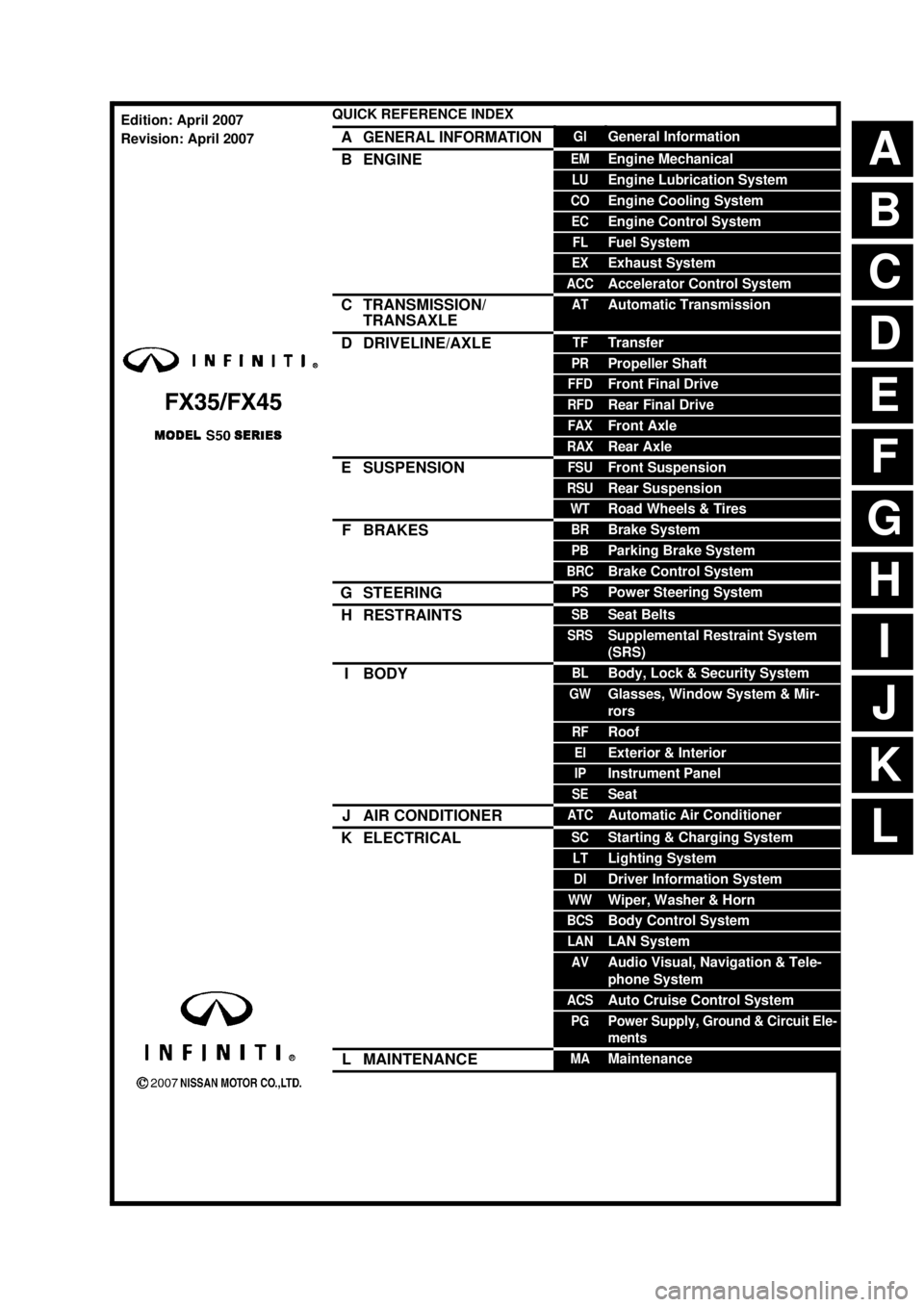



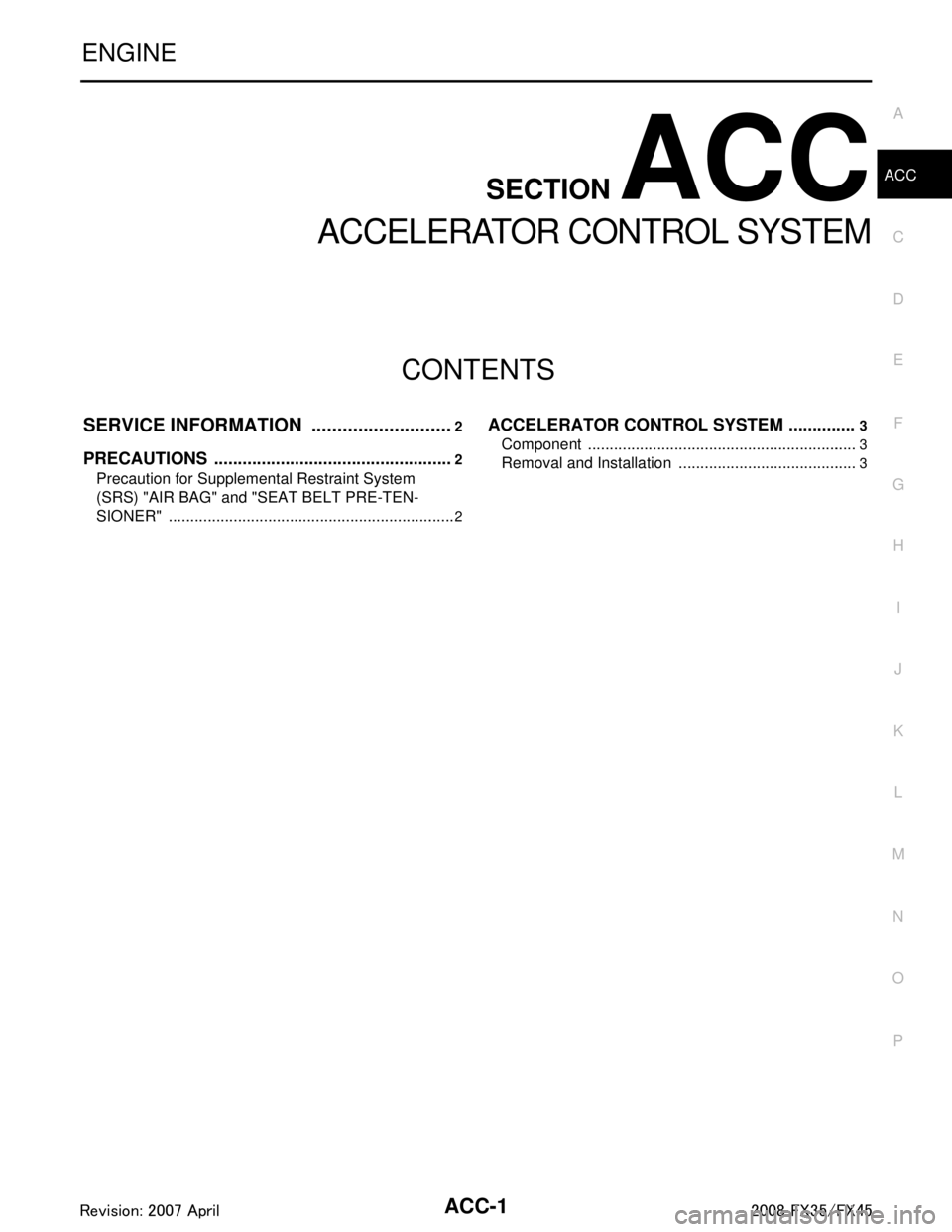
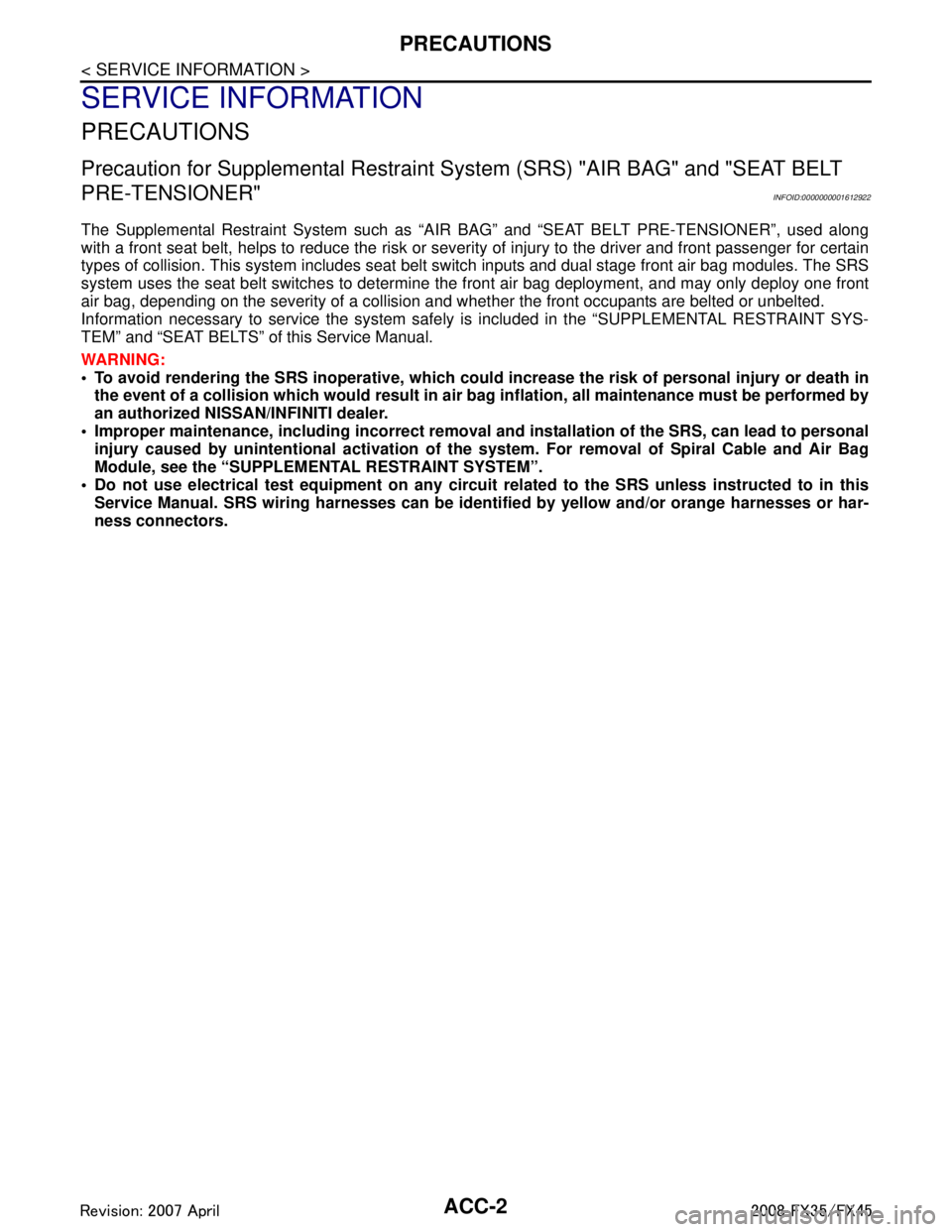
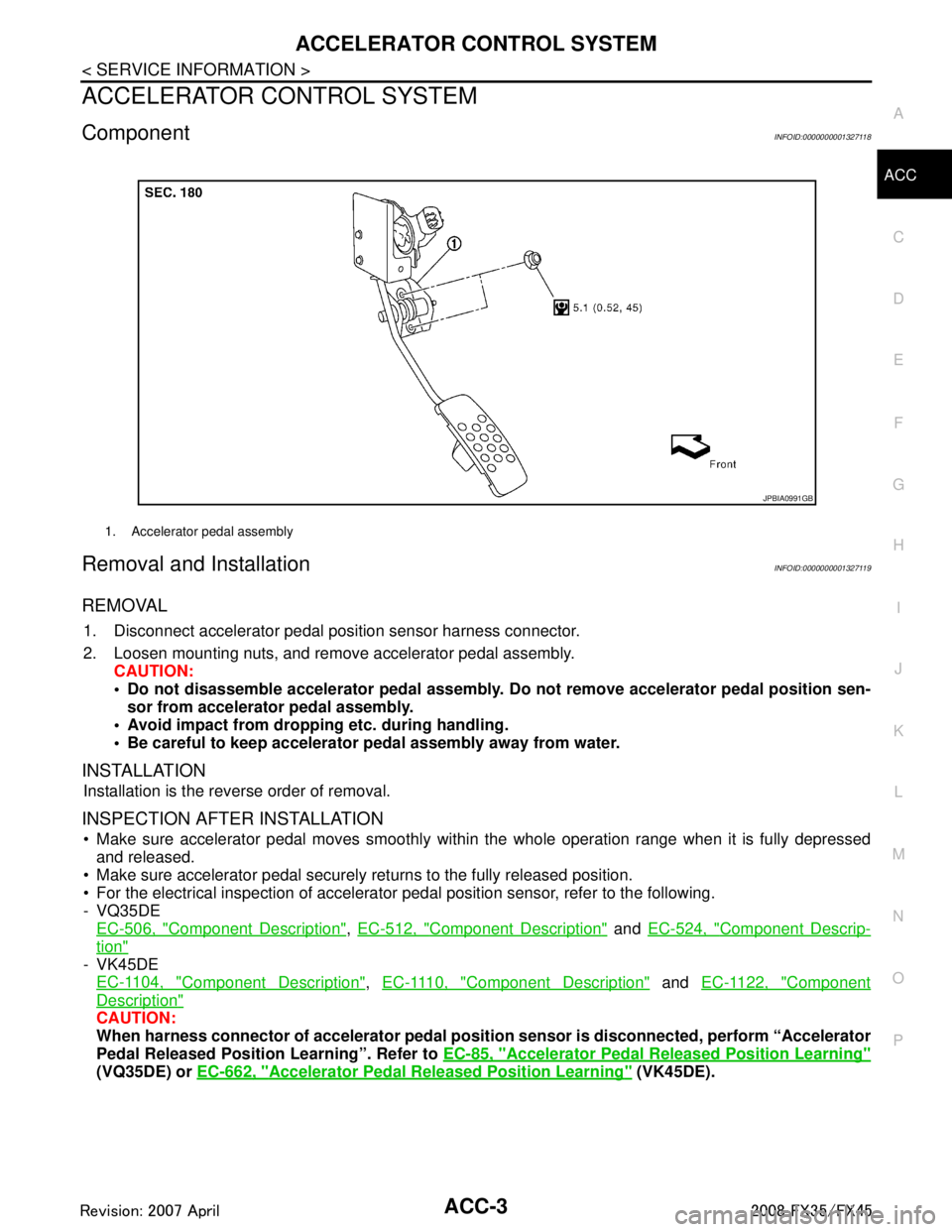
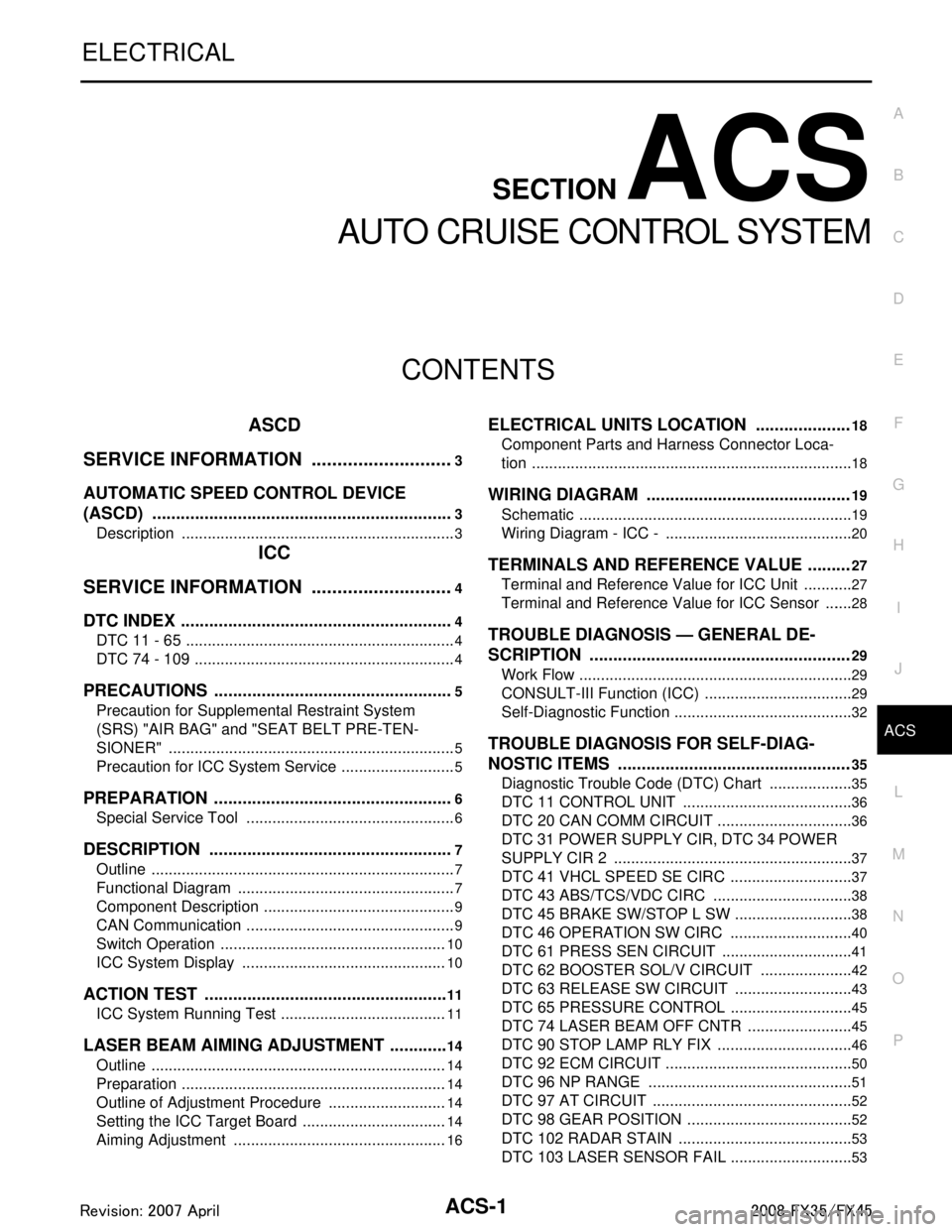

![INFINITI FX35 2008 Service Manual
AUTOMATIC SPEED CONTROL DEVICE (ASCD)ACS-3
< SERVICE INFORMATION > [ASCD]
C
D
E
F
G H
I
J
L
M A
B
ACS
N
O P
SERVICE INFORMATION
AUTOMATIC SPEED CONTROL DEVICE (ASCD)
DescriptionINFOID:000000000132880 INFINITI FX35 2008 Service Manual
AUTOMATIC SPEED CONTROL DEVICE (ASCD)ACS-3
< SERVICE INFORMATION > [ASCD]
C
D
E
F
G H
I
J
L
M A
B
ACS
N
O P
SERVICE INFORMATION
AUTOMATIC SPEED CONTROL DEVICE (ASCD)
DescriptionINFOID:000000000132880](https://www.carmanualsonline.info/img/42/57017/w960_57017-9.png)





